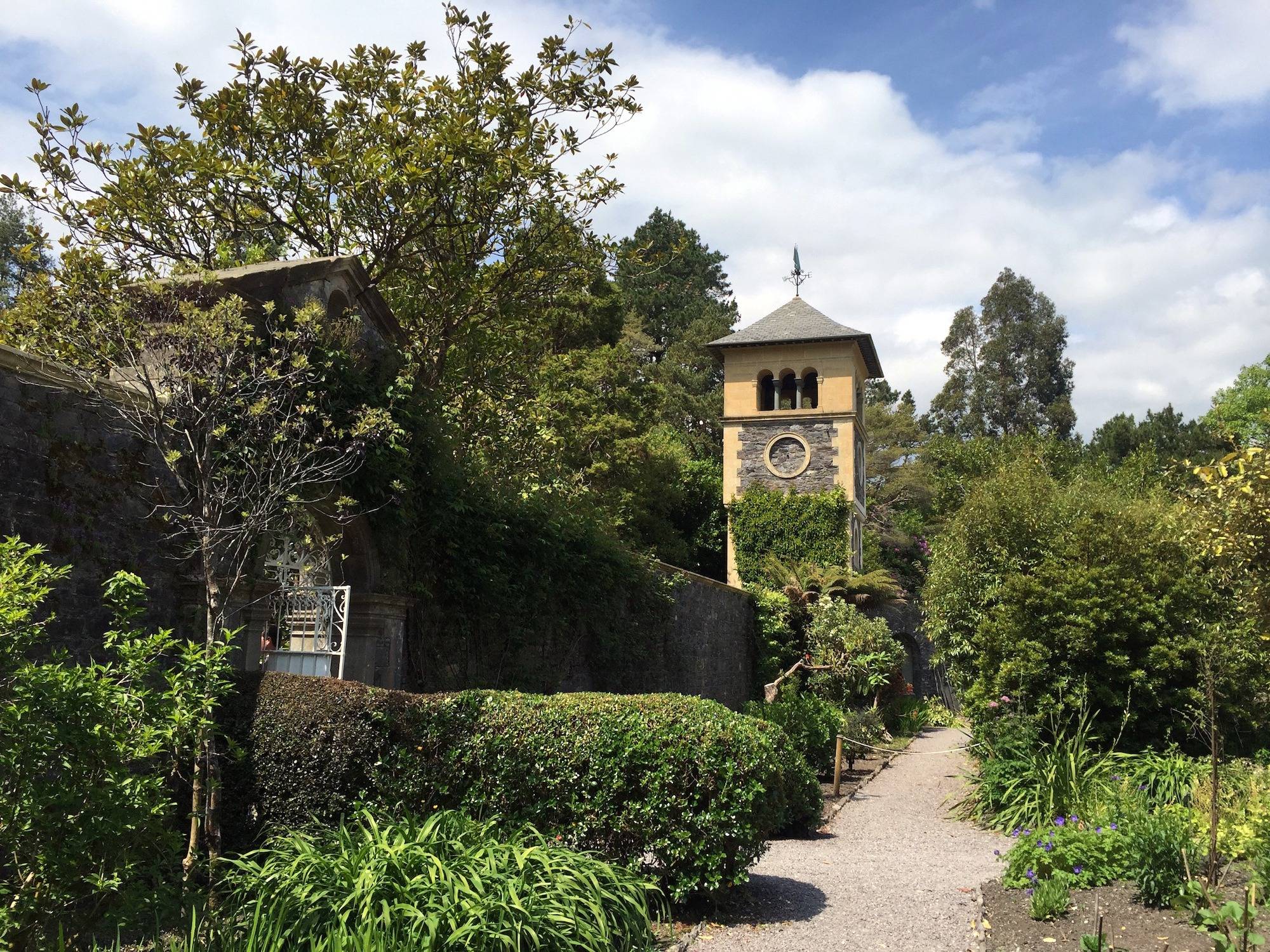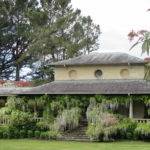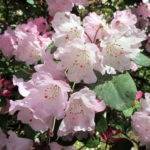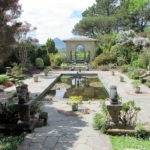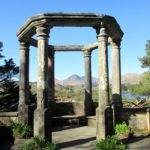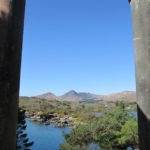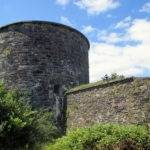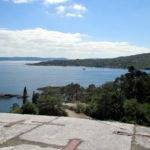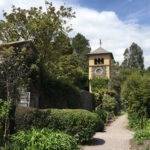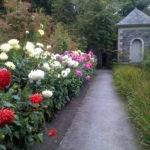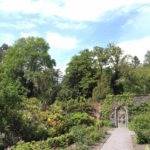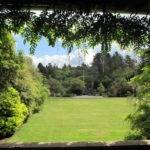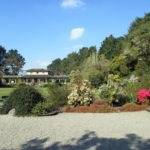The Italian Garden
The sunken Garden is one of Ilnacullin’s outstanding features, with beautifully placed and elegantly proportioned colonnades, steps, raised terraces and garden structures arranged around a formal pool and enclosed by clipped Yew hedges. All elements blend ingeniously with the natural setting.
The Casita, a tea-house described by Peto as ‘the garden house’, accommodated guests playing croquet or tennis on the adjacent lawn. It is suggested that the Casita was inspired by the sixteenth-century Pavilion of Carlos V in the gardens of the Alcázar of Seville, Spain, which Peto had visited in 1888. The Casita is built of Bath stone with solid teak beams. The interior is panelled with Skyros marble (from the Greek island of Skyros), set in Carrara marble from Tuscany. Standing centrally, beneath the Casita, the view extends over the formal pool and terraces, beyond the pavilion (the Medici House) and its red Rosso Antico columns, to the Caha Mountains. The defined peak is the Sugarloaf. The statue in the centre of the pool is of the flying Mercury.
The plants that adorn the Italian Garden are rich and varied. The borders contain selected bedding plants carefully blended with exotic fuchsias and the tender Abutilon and Cestrum, both examples of Central and South American species which grow well in the favoured location. A collection of Bonsai specimens adorn the paved area. These include a fine Larix – said to be almost 300 years old. Many fine plants act as a background foil to the Italian Garden. These include Leptospermums (Manuka) of remarkable size, Camellias, the beautiful Callistemons, myrtles and many scented Rhododendrons – notably Rhododendron x ‘Lady Alice Fitzwilliam’.
- The Casita with Wisteria. OPW.
- Rhododendron in the Italian Garden. OPW.
- The Italian Garden. OPW.
The Grecian Temple
At the top of the steps the promontory leads to the Grecian Temple, a roofless rotunda overlooking the sea and Caha Mountains. The Agapanthus (African Lily) give a great show of flowers during the Summer. Returning from the Temple, a long glade known as the ‘Happy Valley’ opens out in front. It is said that at Ilnacullin, Peto was recalling Samuel Johnson’s story about Rasselas, the Prince of Abyssinia, who becomes discontent in the easy enjoyments of ‘the Happy Valley’ and leaves to seek fulfilment and real happiness, becoming more enlightened along the way.
The Happy Valley has an extensive collection of plants from all over the globe. On the left of the glade is the blazing Embothryium coccineum (Chilean fire-tree), Myrtus lechleriana (Myrtle) suffused in cream flowers in May, and the evergreen Drimys winteri (Wintergreen). These are all native to South America and thrive on Garinish Island.
Heading away from the Temple, on the right, a group of Pinus thunbergii (Black Pine) from Japan, provide shelter for a magnificent specimen of the pendulous Lagarostrobos (Syn. Dacrydium) franklinii from Tasmania. This tender tree can only be cultivated in the most favoured gardens. Further along are examples of a miniature Rhododendron, R. yakushimanum from Japan. To the left of the main glade is a diverse collection of trees and shrubs including Eucryphia, Cornus species, oriental spruces and many prized Rhododendron hybrids.
- The Grecian Temple. OPW.
- View from the Grecian Temple. OPW.
The Martello Tower
A long flight of blue shale steps leads up to the Martello Tower, located on the island’s highest point. It was built by the British War Office about 1805 as a defence against the feared Napoleonic invasion. Like other Martello towers in County Cork, its walls are vertical rather than sloping as is usual elsewhere. This is said to be due to the high rainfall which washed the lime mortar out of sloping walls before it could set.
The tower is in an excellent state of preservation and offers fine panoramic views. The viewpoint south of the Martello Tower affords views of Bantry Bay and Whiddy Island. It was in this area of Ilnacullin that Annan Bryce had initially planned to build his residence. The residence, of a huge scale, was planned to incorporate the Martello Tower as a music room. Evidence of quarrying and excavations are still visible today.
- The Martello Tower. OPW.
- View from the Martello Tower. OPW.
The Walled Garden
The walled garden is an unusual shape, possibly because of the island ’s topography. The boundary walls are buttressed on the outside, enabling the inside to support an exceptional collection of climbing plants, notably Clematis species and hybrids, including well known cultivars such as C. ‘Lasurstern’, C. ‘Nelly Moser’, C. ‘Marie Boisselot’ and the petunia-red C. ‘Ernest Markham’. On the south facing wall on the right a rich collection of rambling roses, notably Rosa ‘Chaplins Pink’ and R. ‘Francic B Lester’ provide richness of colour throughout the summer months.
A fine double-sided herbaceous border runs through the middle of the Walled Garden. Here, careful blending of herbaceous and bulbous plants, with specimen shrubs as a background foil, makes this one of the outstanding horticultural features of Ilnacullin. Look out for varieties of Aster, Centaurea, Delphinium, Erigeron, Euphorbia and spectacular Dahlias.
Each of the four corner towers is of a different design and Peto’s plans indicate they were each to have a particular use. The taller northwest structure with the roundels was to be a ‘Clock Tower,’ the southwest and northeast corners were to be ‘Garden Houses’, and southeast corner was intended for the storage of tools. Each of the towers is constructed from Bath stone. Look out for the highly ornate Roman marble sarcophagus which bears many fine sculptures. A magnificent specimen of the rare Michelia doltsopa / Magnolia doltsopa (Sweet Michelia) from the Himalayas can be seen on the left of the sarcophagus. This species is in flower during late spring. This tender plant can only be grown outside in the mildest parts.
- The Clock Tower. OPW.
- Dahlias in the Walled Garden. OPW.
- The Walled Garden. OPW.
The Lawns
The open lawn area and gravel seating area were formerly laid out as croquet and tennis courts. The end of the lawn by the walled gardens was bordered by clipped hedges with topiary birds, and from inside the walled gardens it would have looked like the birds were sitting on the walls. Originally, the lawns would have been an area of bog, which is gradually sinking. Today the borders contain such plants as the tender Beschorneria yuccoides and the graceful Viburnum plicatum ‘Lanarth’ on the right, backed by fine specimens of Magnolia, Leptospermum, Azara and Ceanothus. The borders include Pieris ‘Murdo Mackenzie’ in addition to many varieties of Rhododendron, Camellia, Hydrangea and Fuchsia. The imposing view of the Wisteria-clad Casita is complemented by the heather bank on the left and the mixed lawn border with its fine collection on the right. A centenary garden was established to the right of the lawn to mark the 100th anniversary of the acquisition of Garinish Island by Annan Bryce.
The lawn border contains fine specimens of Crinodendron (Chinese Lantern Tree), Piptanthus (Evergreen laburnam) from Bhutan, and the exotic Acradenia frankliniae. A profusion of colour from many varieties of Ceanothus, Olearia, Magnolia, Pieris and the handsome Melianthus major make this lawn border interesting and varied over a long season.
- View of the lawns from the Casita. OPW.
- View of the lawns. OPW.
